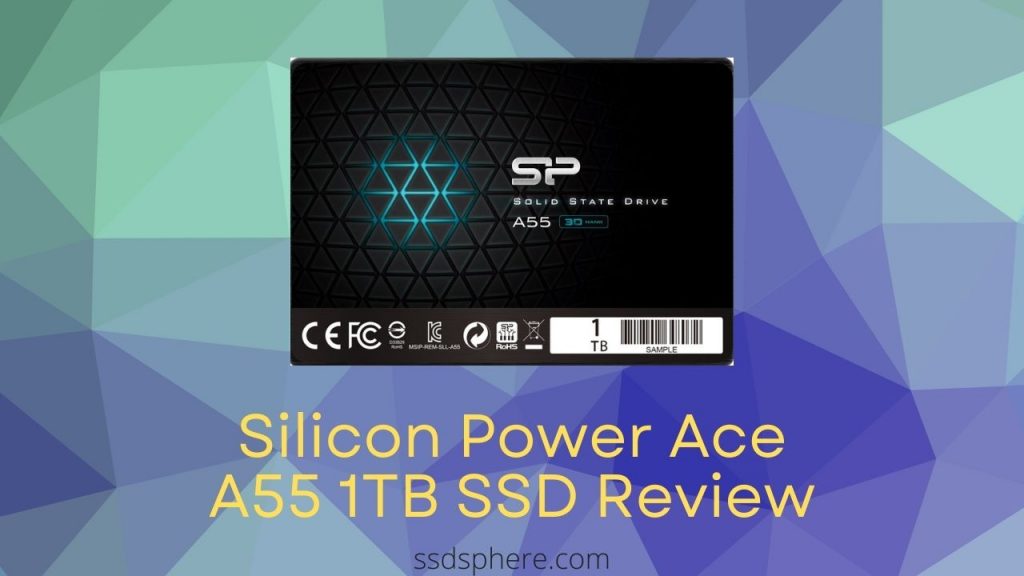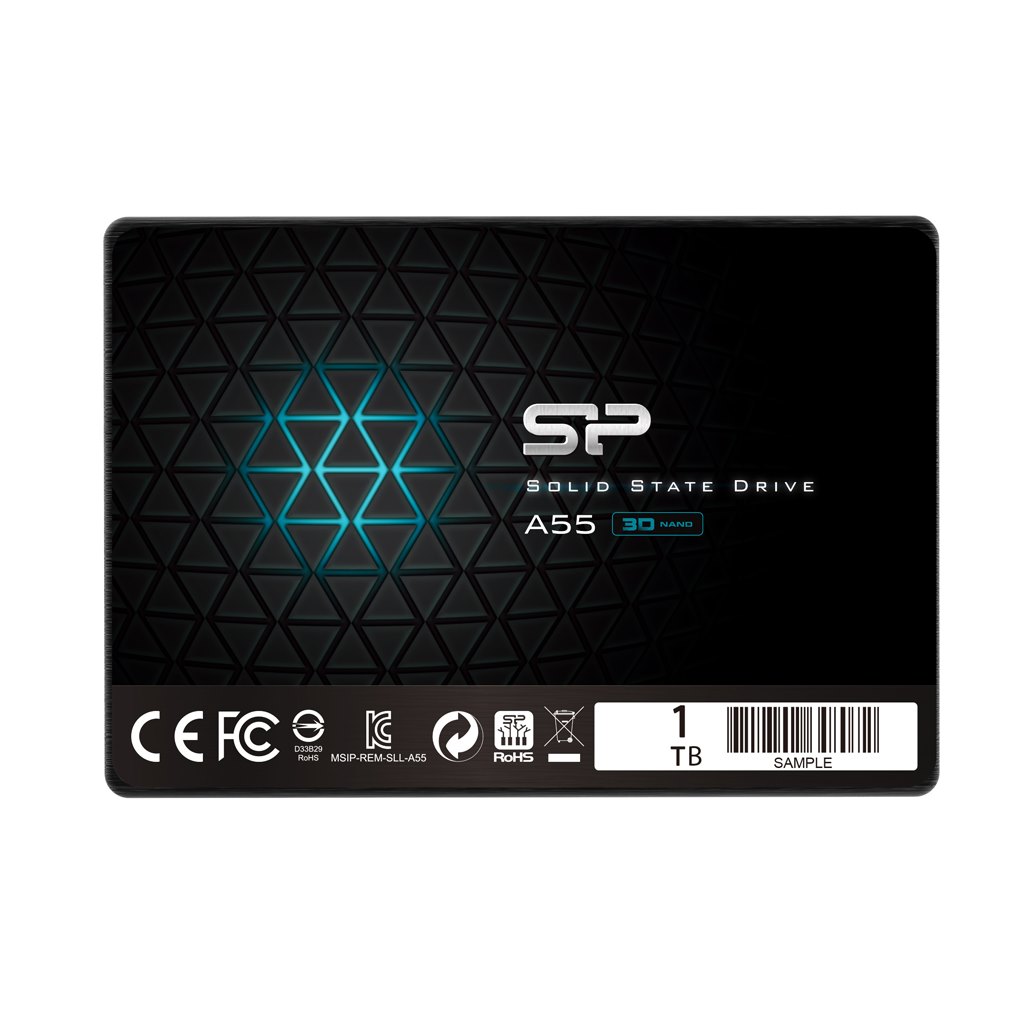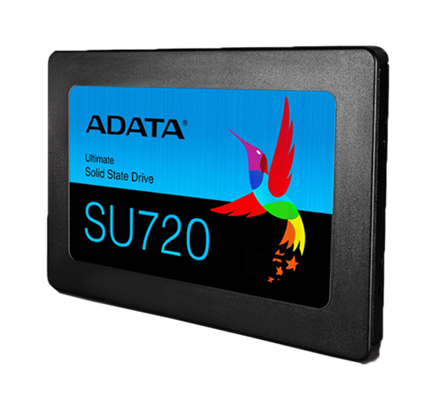On SSD Sphere, I have discussed numerous SSDs from Silicon Power. Today, after seeing a lot of requests, I am going to review the Silicon Power Ace A55 1TB SATA-3 SSD. As the company says itself, it is a consumer SSD. However, I found it really a consumer-level product that actually comes in the light-SATA category.
Now, after my research online, I found that this one is popular as a storage SATA SSD. But, the results that I found with this one were really impressive. In fact, this SSD can easily beat most of its competitors in the market. The main thing to notice about the Ace A55 is that it is Dram-less SSD. However, it is using the SLC caching technology.
The company says that it is an “Ace deal for an easy upgrade”. So, we are going to check whether that’s true or not. Coming to our review, I have reviewed just the 1TB variant. So, some things might be up or down depending on your variants. For your information, the available storage variants are 64GB, 128GB, 256GB, 512GB, 1TB, and 2TB. Now, without any further delays, let’s get started.

Theoretical Specifications
As always, I am going to start with the theoretical specifications before doing anything else. I know most of you might have a fair idea about them. But, I would surely try to add them here. You can skip to the next paragraph if you are not interested in seeing what the company is saying about its product.
| Specification | SP Ace A55 |
|---|---|
| Storage Variants | 64GB, 128GB, 256GB, 512GB, 1TB, and 2TB |
| Sequential Read Speed (ATTO) | Up to 560 MB/s |
| Sequential Write Speed (ATTO) | Up to 530 MB/s |
| 4K Random Read Speed | Not Disclosed |
| 4K Random Write Speed | Not Disclosed |
| Interface | SATA-3 6Gb/s |
| Form Factor | 2.5″ SATA |
| Cache | SLC NAND |
| NAND Flash | Micron’s TLC 3D |
| MTBF | 1.5 Million Hours |
| Warranty | 3 years Limited Warranty |
| Price | Check Amazon |
These specifications might look great at the first glance. But, you can see that the random read/write speeds are not disclosed by the brand. That’s a shady thing for me. But, that’s all up to the. The next thing is the 3-Years limited warranty. This should have been 5-year. Even very low-end SATA SSDs are now giving you 5 years of warranty periods along with up to 2 Million MTBF. Otherwise, everything else looks fine.
Synthetic Benchmarks
I am again using my intel i5 8th gen test system that has a 3200Mhz DDR4, 8GB RAM. You can expect this SSD to pass all its juice on this system. I have used the CrystalDiskMark8 software to do these synthetic tests. The results are as follows.
| Parameter | Results |
|---|---|
| Sequential Read Speed | 524 MB/s |
| Sequential Write Speed | 475 MB/s |
| Random 4K Read Speed | 39.8 MB/s |
| Random 4K Write Speed | 56.4 MB/s |
| Deep Queue 4K Read Speed | 271.1 MB/s |
| Deep Queue 4K Write Speed | 176.9 MB/s |
I am quite impressed by the sequential read speed this SSD is offering. I even tried using it with huge files and the performance seems to be consistent. However, when it comes to files with a size of more than 1GB, the write speed was plateauing at just 440 to 450 MB/s. But, I just took the average and the results are in front of you. Also, this SSD is doing pretty well with the random tasks as well.
This might be happening because of its fast SLC cache. Overall, I would say that the results of the synthetic test are just perfect.
Software and OS loading/booting times
We all know SSD’s power of reducing those huge software and OS loading times. So, I tested this SSD again in a different way. I used the same test system that I used in the synthetic tests. Then, just like always, I tried firing up certain software. Below are the results that I saw.
| OS/Software/Game | Loading Time |
|---|---|
| Windows 10 Home | ~14 Seconds |
| Google Chrome | ~3 Seconds |
| Adobe Photoshop CC | 22 Seconds |
| Adobe Premiere Pro | 31 Seconds |
| Blender (Animation Software) | 28 Seconds |
| Fortnite | 38 Seconds |
| GTA-5 | 39 Seconds |
These are the results. But, don’t trust them as you see them. These are going to be way different depending on the overall specifications of your computer. If you have more faster RAM and a good processor than mine, you will see smaller numbers than these.
Price
This could be a deciding end for most of the users. If you look at the prices of Silicon Power Ace A55, it is not cheap. At this price tag, you will find various other SSD from WD, Crucial, and Adata, etc. However, SSD prices are not stable so they may vary depending on various things.

Warranty
The Silicon Power Ace A55 comes with a 3-years limited warranty. This warranty period is way lesser than what you will get with most of the SSD in this range these days. The SSDs like Crucial MX500 and SK Hynix Gold S31 will offer you 5-Years of warranty at almost similar price tags.
Along with that, this SSD has 1.5 Million Hours of MTBF which would have been better at the number of 2 Million. The actual TBW ratings are not disclosed by the company.
Technical Specifications
Any SSD review in incomplete if we do not add its technical features and specifications to our list. So, let’s see what the Ace A55 has to offer you inside its body.
| Specifications | SP Ace A55 |
|---|---|
| NAND Flash Type | TLC 3D NAND |
| NAND Flash Layers | 64 Layers |
| Controller | SM2259XT |
| Controller Configurations | Single-core, 4-Channels |
| Cache | SLC NAND Cache |
When I opened up its body, I found that there is no direct contact of this SSD with its body. Even though the casing is made up of metal, it would be better to use it for good heat dissipation. However, as we all know the SATA SSDs don’t tend to heat up so much. So, heating is not a problem at all.
Competitors
If we look at its price tag, this SSD has numerous competitors. But, we are going to take the two most common and very popular products and try to compare them here.
1. Adata Ultimate SU720 SSD

The Adata Ultimate SU720 is also a SATA-III 2.5″ SSD with a maximum sequential data read speed of up to 520 MB/s and write of up to 450 MB/s. The only available storage variants are 1TB and 2TB. This SSD also has SLC caching and the same 3-years limited warranty period. Its price might be way lower than the SP Ace A55 but it also comes with comparatively lower data read/write speeds. You can read the full review here.
2. Crucial MX500

Crucial MX500 is a beast in the SATA SSD category. It is inexpensive but directly competes with popular SSDs from Samsung. It has a TLC NAND Flash along with a DRAM cache and a 5-Years Warranty. The price is almost similar to that of the SU720. So, it should definitely be your choice if you don’t want to go for the SP Ace A55.
Comparison Table
| Specifications | Adata Ultimate SU720 | Crucial MX500 | SP Ace A500 |
|---|---|---|---|
| Storage Variants | 1TB and 2TB | 250GB- 4TB | 64GB- 2TB |
| Speed | 520/450MB/s | 550/510 MB/s | 560/530 MB/s |
| NAND Flash Type | QLS 3D NAND | TLC 3D NAND | TLC 3D NAND |
| Cache | SLC Cache | DRAM Cache | SLC Cache |
| Category | Storage SATA | Performance SATA | Consumer SATA |
| Warranty | 3-Years Limited | 5-Years Limited | 3-Years Limited |
In my opinion, choosing any of these is definitely going to be a good decision for you. If you are tight on budget and can’t afford those expensive SATA SSDs, you can just go for any of these three.
Conclusion: Should you buy SP Ace A55 SSD?
Definitely, the Silicon Power Ace A55 is a completely worthy product in the budget SATA category. However, its limited 3-years warranty is the only thing that troubled me. But, overall, I would strongly suggest this SSD for anyone who is looking for a high-performance SSD for gaming, video editing, or any other hardcore tasks.
This SSD is capable of offering you a better speed than its main competitors in the market. So, it is definitely a good option to go with. Any SATA-3 SSD can never offer you more than 600MB/s data read or write speed. So, whatever you are getting with this budget-friendly product is just great.
Thanks so much for this. You are a life saver.
how do you know that “sp ace a55” have tlc nand, it’s not specified on producer site, they said only it’s 3d nand
Most companies won’t specify that anywhere. But, there are ways to find out. One of them is by looking at the NAND chip physically.